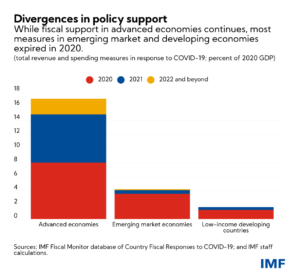
The failure to control the COVID-19 pandemic has had far reaching impacts on the global economy, with global GDP falling by 3.3 percent in 2020. Even with the global economy projected to grow by 6 percent in 2021, recovery will depend on equitable distribution of the vaccine globally. Failure to do so could cost the world economy up to $9 trillion, according to the International Chamber of Commerce, with the costs born equally by wealthy and poor countries, causing more economic devastation than the 2008 financial crisis.
The global economic downturn is having a disproportionate impact on low-income and emerging economies. They will take the hardest hit, according to Kristalina Georgieva, Managing Director of the International Monetary Fund, as they have “less resources to protect themselves against this dual…health and economic crisis.” World Bank President David Malpass also warned that the global recession could set back decades of progress in low-income countries, stating that the COVID-19 pandemic would lead to higher infant mortality rates and stunted growth for children.
Vaccine access has emerged as the leading determinate of global economic recovery, particularly for low-income and emerging economies.
Rand Corporation estimates changes in real annual GDP for four scenarios:

Differences in ongoing financial support are degrading economic growth and recovery prospects for low-income countries.

Regional Assessments
Foreign direct investment flows – a critical source of financing for emerging and developing economies – fell by 42 percent in 2020, with expectations FDI will remain weak due to pandemic related uncertainty. Low-income countries saw more than $100 billion flowing out from the region in early 2020 – more than three times the amount during the global financial crisis. The dramatic capital outflow led to major emerging market currencies depreciating by 15 percent and forcing people to pay more for imported goods. UNCTAD projects a 5-10% FDI slide in 2021.
The World Bank is providing $160 billion in financing – the largest response in its history – to help 100 low-income countries respond to the health, economic and social impacts of COVID-19, including $50 billion of resources on grant and highly concessional terms, and $20 billion for vaccine purchase and distribution.
Last updated August 2021